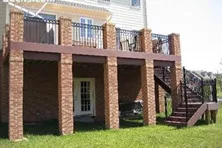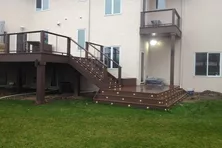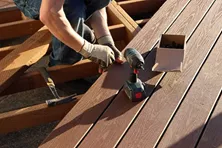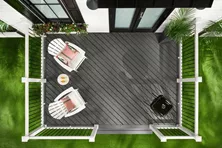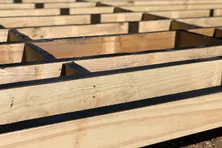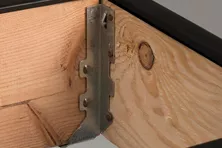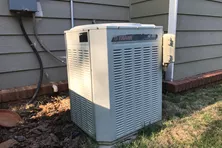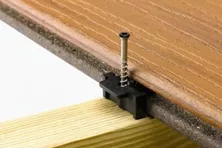Deck Joist Sizing and Spacing
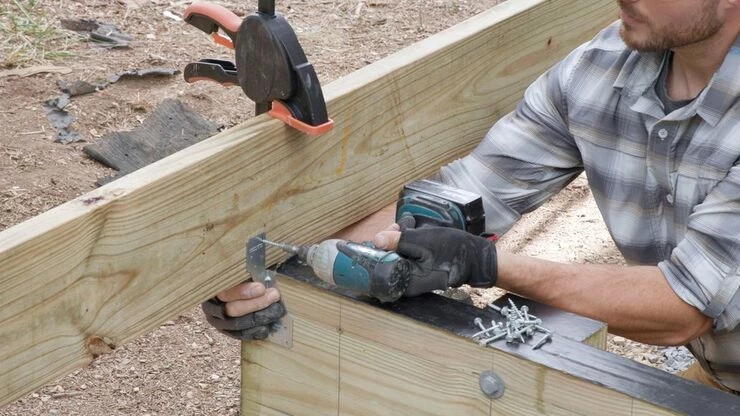
Bringing your favorite people together to enjoy a beautiful summer day on your deck is a great way to unwind and relax. And while it’s important to have a deck that’s aesthetically pleasing to you, you first have to make sure it’s structurally sound. That includes knowing the difference between a joist and a beam and what purpose they serve to your deck and its functionality and safety.
What Is a Joist?
Joists are the repeated structural members that are used to build a deck frame. The minimum size joist used in deck construction depends on the distance the joists span between bearing points and the species and grade of the treated lumber used to create the joists. The building code has very stringent minimum standards for the amount of weight a deck floor must be able to hold. You can determine the size of the joists using a span table.
What Is a Beam?
A beam is the main load-bearing element for the structural soundness of your deck. It’s not only responsible for supporting the weight of the joists but other building elements as well.
The joists sit on top of a beam or are attached to a beam using joist hangers. Beams away from the house are almost always supported by vertical posts or columns. The size and construction of beams are very important and should be specified by an architect, a residential structural engineer, or the building department of your local municipality.
How Far Apart Should Deck Joists Be Spaced?
A lot of questions revolve around joists when it comes to building a deck.
- What is the proper placement?
- How far apart are floor joists placed?
- How do I keep them even?
The normal spacing for deck joists is 16 inches on center. Before you build a deck, verify this with your local building department and read the installation instructions for the decking material. Some decking materials installed at a 45-degree angle to the run of the joists require the joist spacing to be 12 inches on center.
Your joist span will depend on the size of the joists (i.e. 2X8 vs 2x10 vs 2X12). See the below span chart as well as the local codes and guidelines for your jurisdiction. The larger the span, the larger the joists.
In typical deck construction, with a ledger on one end of the joist and a beam on the other, the size of the joists is driven by the size of the deck and based on the general maximum spans mentioned above. For best results, refer to our wood and composite deck joist span table.
You can also use Decks.com’s Joist Span & Spacing Calculator to determine how long your deck joist should span.
Deck Joist Spacing by Wood Type & Deck Size
| Joist Spacing (o.c.) | 12" | 16" | 24" | |
|---|---|---|---|---|
| Species | Size | Allowable Span | ||
| Southern Pine | 2x6 | 9'-11" | 9'-0" | 7'-7" |
| 2x8 | 13'-1" | 11'-10" | 9'-8" | |
| 2x10 | 16'-2" | 14'-0" | 11'-5" | |
| 2x12 | 18'-0" | 16'-6" | 13'-6" | |
Douglas Fir-Larch, Hem-Fir, Spruce-Pine-Fir | 2x6 | 9'-6" | 8'-4" | 6'-10" |
| 2x8 | 12'-6" | 11'-1" | 9'-1" | |
| 2x10 | 15'-8" | 13'-7" | 11'-1" | |
| 2x12 | 18'-0" | 15'-9" | 12'-10" | |
Redwood, Western Cedars, Ponderosa Pine, Red Pine | 2x6 | 8'-10" | 8'-0" | 6'-10" |
| 2x8 | 11'-8" | 10'-7" | 8'-8" | |
| 2x10 | 14'-11" | 13'-0" | 10'-7" | |
| 2x12 | 17'-5" | 15'-1" | 12'-4" | |
What are Joist Hangers?
Joist hangers are used to attach the ends of joists to the face of a beam or a ledger board. Joist hangers must be of the highest quality and approved for contact with the newer treated lumber that has a higher copper content. Each time it rains, a chemical brew is created from the rainwater touching the joists. This solution will corrode substandard joist hangers and the fasteners used to connect them to ledger boards and flush beams.
What About Attaching Joists to Ledger Boards?
Be particularly cautious to follow an approved ledger connection method to the house. Always follow local code guidelines for installing and properly flashing the ledger board, or consider building your deck as a freestanding structure. Incorrectly installed ledger boards account for many decks collapses every year. Refer to the Decks.com article on ledger boards for more information.
What are Other Joist Installation Considerations?
Joists are rarely perfectly straight. Most have a crown to them. Crowns can be very helpful in preventing low spots mid-span in joists that are heavily loaded. You’ve probably never paid attention as you cross one, but almost all bridges have a crown to them for the same reason.
If you identify a crown on the board, you should always install it with the hump pointing upwards to the sky.
The layout term for joists is “On Center,” which is the center-to-center measurement from one joist to the next. Most decks use 16" on center spacing for joists. Most decking is not strong enough to support wider spans than 16". Some builders reduce joist spacing to 12" on center to strengthen the deck frame or to increase maximum allowable joist spans.
Joist Spacing for Composite Decking
Before building a composite deck, always read the installation instructions from the manufacturer, paying special attention to the required joist spacing for that specific composite decking. Most composite decking materials, like Trex composite decking, limit maximum joist spacing for composite decking to 16" on center spacing for straight decking and 12" on center joist spacing for 45-degree angle diagonal decking.
Also, many composite decking materials require 12" or even 9" on center stair stringers spacing to support composite stair treads. If you are installing composite decking over an existing frame, you may need to install new intermediate joists or stair stringers to meet the installation requirements.
Since most composite products are more flexible than their wood counterparts, they don’t hide imperfections in the framing quite as well. This can sometimes cause an uneven surface. That’s why stretching a string across the joist for composite deck boards can help detect spots that may be higher than others. These spots can be addressed with a power hand planer to give you a more uniform surface for the deck of your dreams.
How to Space and Lay Joists For Decking
As they serve an integral role in the structural integrity of your deck, taking the time to learn how to space floor joists is essential to the safety of the final result. Start by ensuring any existing structures are sound.
You’ll also need your deck plan ready, including dimensions and layout for the railing, especially if your railing installation method would otherwise interfere with the blocking of your frame. With a game plan and a little hard work, figuring out how to lay joists for decking can be relatively simple.
Materials & Tools Needed
You may need:
- Miter Saw
- Hammer
- Tape measure
- Drill
- Chalk Line
- Level
- Pencil/marker
- Wood screws
- Fasteners
- Spare Lumber
- Safety Glasses
Step 1: Layout the first joist position on an angle.
Start your layout from one end of the rim joist and work towards the other. The position of your first joist will help guide the placement of the rest and make placing each subsequent board simpler. For an angled corner, you can use a scrap piece of wood as a guide to situating the first joist into position.

Step 2: Use a sharpie or construction pencil to mark your joists.
Mark out floor joist spacing locations at 16" on center spacing on the header with a pencil, marker, or chalk line. Draw an X on the side of the line where you want your boards to set. This can help plan the layout for the location of hanging hardware.

Step 3: Toenail the joist to the rim joist.
Ensure the top of the joist is flush with the header, then connect the rim joist and first joist using screws or nails. Using a support beam can keep the joist in position while the connection is made. Keep in mind that toenailing boards are inadequate for 75+ mph winds. In high wind areas, you’ll need to secure each with hurricane clips.

Step 4: Use a chisel to notch beams to create a level frame.
Notching a joist over a beam. This joist was 1/4" higher than all the others. You can notch out a section of the joist or add shims to a narrow joist to even out the top of the deck frame. Be careful to not exceed the maximum allowed notch size in different locations of the beam spans.

Step 5: Always fill all the nail holes for deck hardware.
Structural screws that have a corrosion-resistant coating provide a much better connection than nails. The hole created by the nail can enlarge over time by expansion and contraction caused by the wetting and drying of the lumber. Read the label on the box of structural screws to ensure they match the correct joist hanger. Simpson Strong-Tie manufactures a full line of approved hangers and structural screws. Don’t skip any of the available nail hole spaces, as each is necessary for the stability, longevity, and safety of your deck. Failing to do so may also affect warranties.

Step 6: Inspect the board and trim off the rougher edge.
Measuring the 2x10 pressure treated joist length to prepare for cutting. Use a speed square to square off your joists. Pay attention to the crowning of the board for placement.

Step 7: Install Joists Crown Side Up at Center
Continuing from your first joist, install additional 2x10 pressure treated joists in sequence. Connect beams at 16" on center (or your required spans as determined above). Be sure to install the joists' crown side up, ensuring any bowing in the board is facing upwards. Don’t forget to lift joists with your knees!

Step 8: Install Hurricane Tie to Each Beam Connection
Use a Simpson Strong-Tie H2.5Z Hurricane Tie, or equivalent, on every joist-to-beam connection. Once again, use Simpson structural screws instead of nails. Keep in mind that hurricane ties are not a replacement for solid blocking. And if you’re installing ties on plated trusses, don’t complete the fastening from behind the truss plate, as doing so can compromise the performance of the hardware.

Building a safe frame can be challenging work because even the smallest mistakes need to be remedied. Finding professional deck contractors near you can ensure your project is completed in accordance with all local codes, constructed on schedule, and up to the highest standards. You can also use our find a retailer tool for the most appropriate materials or kits to make installation easier.
How to Decorate Deck Support Columns
Browse some examples of decorative deck support posts for tall decks.
Building a Balcony Deck
Learn information about balcony decks that use cantilevered joists that attach to house floor truss systems.
How to Install Deck Girder, Cantilever or Drop Beams
Learn about the pros and cons of installing a cantilever, girder or drop beam to support your deck joists. This method allows for a notched post-to-beam connection.
How to Install Decking Over Existing Concrete Slab, Patio, or Porch
Discover the best techniques to build a deck over concrete, ensuring proper drainage and stability, while creating a beautiful outdoor space.
Best Time to Build a Deck
People often wonder when the best time to build a deck is. Learn why building a deck in winter or fall might be your best bet.
Dos & Don'ts for Homeowners to Consider When Building a Deck
Your dream deck can take whatever shape you like. The trick is making it fit your budget and site conditions. While the deck doesn’t have to be built as a rectangle, there could be good reasons for doing just that.
More Helpful Resources
Explore Articles by Topic

Footings
Information related to installing frost footings for decks

Framing
Learn structural framing methods

Decking
Learn about wood and composite decking materials

Stairs
An in-depth look at the complex issue of how to build stairs

Railings
How to install guardrails and handrails to meet IRC code

Features
An overview on water drainage, benches, planters and lights

Design
The basics of deck design

Planning
Learn about permits and working with contractors

Porches & Patios
Build a covered deck to enjoy all seasons

Ledger
Proper attachment techniques

Care
Maintain your deck to maintain your investment

Materials
An overview on water drainage, benches, planters and lights
Why is Joist Protection so Important for Your Deck?
If you’ve ever seen a piece of wood left out in the weather for any period of time, you know what happens: decay. Whether through wet rot, insect damage, or mildew, the fibers begin to break down.
Deck Joist Water Protection
Learn about a technique used by many pro builders for wrapping deck framing lumber with a waterproof barrier to prevent corrosion and rot.
Building A Deck Over An Air Conditioner
Things to consider when building a deck near an air conditioning unit. You may want to relocate the AC unit if possible to avoid some problems.
What to Consider When Building A Wrap-Around Deck
Looking to add a wrap-around deck to your home but unsure of what the process involves? Check out this guide to learn more about top considerations when building a wrap-around deck.
Best Hidden Fasteners for Decking
Hidden fasteners create a clean deck surface and can be used with composite, wood and other materials. Learn about hidden deck fasteners at Decks.com.
How to Install Decking Over Existing Concrete Slab, Patio, or Porch
Discover the best techniques to build a deck over concrete, ensuring proper drainage and stability, while creating a beautiful outdoor space.
Explore Articles by Topic

Footings
Information related to installing frost footings for decks

Framing
Learn structural framing methods

Decking
Learn about wood and composite decking materials

Stairs
An in-depth look at the complex issue of how to build stairs

Railings
How to install guardrails and handrails to meet IRC code

Features
An overview on water drainage, benches, planters and lights

Design
The basics of deck design

Planning
Learn about permits and working with contractors

Porches & Patios
Build a covered deck to enjoy all seasons

Ledger
Proper attachment techniques

Care
Maintain your deck to maintain your investment

Materials
An overview on water drainage, benches, planters and lights




